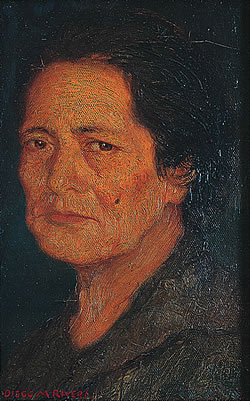
Retrato de la madre del pintor, ca 1904
Oleo sobre tela 32,5 x 21,5 cm.
Colección del Gobierno del Estado de Veracruz
La figura humana y el retrato
Desde el siglo XVIII, la pintura de mujeres en la intimidad, como imagen misma de la recién inventada privacidad, o como signo de lo cotidiano, desarrolló todo un género en la historia del arte. Rivera lo experimentó a lo largo de su carrera artística, donde se puede observar el desarrollo de las distinas técnicas, escuelas y formas de aproximación a la figura humana, hasta llegar a plasmar de manera magistral las famosas vendedoras con flores.
En el tratamiento del retrato se pueden observar sus diferentes etapas como pintor. En algunos de ellos se observan reminiscencias de caracter expresionista, como por ejemplo en el Retrato de su mujer Lupe Marín de 1914. El estilo clásico, de factura académica está presente en el Retrato de su madre, y en el Desnudo que sorprende por vuelta a la sensualidad y al tratamiento clásico luego de haber transitado las vanguardias.
La influencia cubista es notoria en el Retrato del Escultor donde no solo la composicón escultórica sino el uso de ocres y grises muestran las leyes constructivas del cubismo.
La salida del cubismo y la ironía presente ya con la inclusión de la caricatura se puede observar en Retrato de actriz.
Estos cambios estílisticos a lo largo de su carrera hasta alcanzar sus famosos íconos donde recupera lo autóctono, muestran un Diego Rivera aprendiendo todas las escuelas, todas las técnicas y dando a cada una su original impronta. Este conjunto también da cuenta de las etapas de formación de los artistas latinoamercianos de las primeras décadas del siglo XX.
Since the XVIIIth century, the painting of women in private, as an image of the just invented privacy, or as a sign of the daily thing, becomes a style in the history of art. Rivera experienced it throughout his artistic career. It is possible to see the development of the different techniques, schools and forms of approach to the human figure, until arriving to the famous saleswomen with flowers.
In the portraits, his different stages as a painter can be observed. In some of them we can see reminiscensenses of an expresionist character, for example in the portrait of his wife Lupe Marín of 1914. The classic style, the academic making is present in the portrait of his mother, and in the Nude that surprises by his return to the sensuality and the classic processing after have journeyed the vanguards.
The cubist influence is remarkable in the Portrait of the Sculptor. In this work, the sculptoric composition and the use of the ochers and grays show the constructive laws of the cubism.
The exit of the cubism and the irony present in the inclusion of the cartoon can be observed in Picture of an Actress. These changes of style throughout their career until reaching his famous icons where he recovers the native thing, show a Diego Rivera learning all the schools, all the techniques, and giving each one their original mark. This assembly also illustrates the stages of formation of the Latinamerican artists of the first decades of the XXth century.